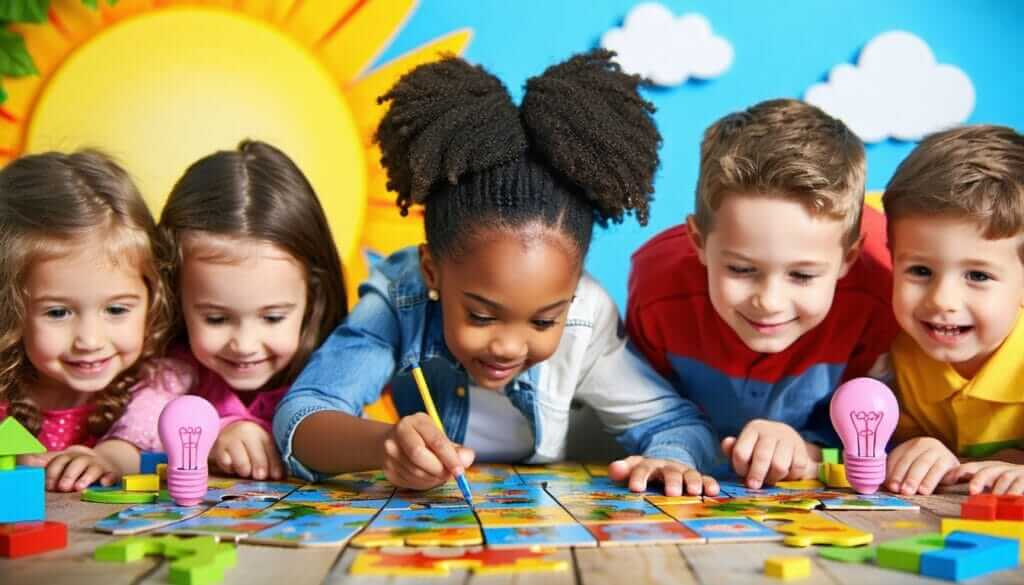Nurturing a Positive Mindset
Impact of Positive Emotions
Encouraging sunny vibes in your kiddo can do wonders! Let them soak up good emotions, and boom—you’re already laying the groundwork for their future happiness and adaptability. Some studies say that happy feelings can help build important skills and mental resilience (NCBI). According to the brainy folks who know about the broaden-and-build theory, those warm fuzzies actually help create a treasure chest of success tools over time.
Fill your child’s day with positivity, and you’re also boosting their ability to roll with the punches. Even the simple stuff like saying thanks, playing with pals, or saying “I can do it!” in the mirror counts. Never underestimate the power of a daily dose of happy! Wanna help them see more rainbows? Check out some positivity activities for kids to make joy a regular guest in your home.
Building Ego-Resilience
Ego-resilience, kind of like a superpower, lets kids handle life’s rollercoasters without losing their cool. Research shows that kids who’ve got it can breeze through tough times and bounce back like a rubber ball (NCBI). Teaching them to think positively can seriously pump up their ego-resilience.
Here’s how to get started:
- Strut the Talk: Lead by example. Show your child how to tackle problems with a can-do spirit.
- Encourage DIY Solutions: Let them work through their own challenges. Building confidence in their abilities pays off in the long run.
- Celebrate Wins: Clap for even the small victories. It boosts their “I got this” vibes.
Take a swing by our tips on instilling optimism and resilience in kiddos for some golden advice on nurturing their emotional strength. By pouring regular positivity into their lives, you’re prepping them to handle curveballs and turn life’s little bumps into stepping stones.
Problem-Solving Skills in Children
Importance of Problem-Solving
Problem-solving is like a secret weapon kids can use to handle life’s hurdles. These smarts aren’t just for acing school exams or dealing with tricky situations between pals but also for building a foundation that’ll hold up as they grow. Research from Marlborough School points out that sharpening these skills boosts grades and confidence—what a combo!
Here’s a handy table to show some of the magic of problem-solving in a kid’s world:
| Importance Level | Description |
|---|---|
| High | Prepares children for academic and social curveballs. |
| Medium | Swagger and self-reliance in making choices. |
| High | Cranks up creativity and innovation, turning kids into adaptable all-stars. |
Benefits of Developing Skills
Teaching kids to become expert problem-solvers is like handing them the keys to a bright future. Kids with these skills keep cool, think creatively, and stay persistent during tough spots. These qualities boost their confidence and align with what experts call a growth mindset, meaning they’re ready to bounce back from setbacks (Big Life Journal).
Check out these perks of encouraging problem-solving in kids:
| Benefit | Description |
|---|---|
| Improved Academic Performance | Kids with a knack for solving problems do better on tests and assignments—real score boosters! |
| Increased Confidence | Tackling tough challenges can turbo-boost kids’ self-esteem and belief in their abilities. |
| Career Readiness | Employers love problem solvers, so your child could be a hot commodity in the job scene someday (Marlborough School). |
To really amp up these skills, jump into some positive thinking activities for children and set the stage for creativity and exploration at home. By backing your kid in building these superpowers, you’re setting them up for a positive outlook and overall happiness.
Teaching Creative Problem-Solving
Creative Problem-Solving (CPS)
Giving your kid the tools for Creative Problem-Solving (CPS) is like gifting them a superpower to handle life’s sticky bits with flair and confidence. Imagine them facing social hurdles or confusing new scenarios, and rising above it all. That’s the magic of a good CPS mindset—they’ll start seeing bumps as just another adventure (Invent – NIHF).
CPS shines brightest in group settings. Team efforts usually brew some of the best ideas and inventive fixes. While they’re bouncing thoughts around, kids learn the beauty of teamwork and shift their focus from “I” to “we”. Get the wheels turning by organizing team-based activities: think group puzzles or creative projects that spark fresh ideas.
Now, adding a dash of creativity into their daily schedule could work wonders in beefing up CPS skills. Informal get-togethers, like a LEGO block-building competition or art sessions, can turbocharge their creative juices, turning them into problem-solving machines.
Facilitating Innovation Mindset
Instilling an innovation mindset in your kid is like giving their creativity and problem-solving skills a turbo boost. Encourage them to see hurdles not as roadblocks but as fun challenges to beat. Help them get comfy with asking endless “what if” questions, nudging them to brainstorm a sea of potential solutions for any issue.
Be their problem-solving role model. When life’s little hiccups come your way, talk them through your game plan. This not only shows that grappling with problems is perfectly normal but also paints a sunny picture of how to tackle them head-on (Sanford Health).
Consider these strategies to spark that innovative streak:
| Strategy | What to Do |
|---|---|
| Foster Curiosity | Prompt your kiddos to keep asking questions and explore their world. Curiosity is their new best friend. |
| Embrace the Oops | Show them even mistakes teach lessons. Chat about what they can take away when things go wrong. |
| Cheers to Effort | Celebrate the trying, not just the triumph. Applaud their problem-solving tries to build them up bit by bit. |
| Supply the Goods | Hand over toys that double as learning tools—think painting kits or construction sets—to fuel those creative flames. |
By nurturing that creative problem-solving and innovative edge, you’re giving your child the thinking superpower they’ll need to blaze through life’s challenges with confidence and zest. They’ll be ready to tackle anything, armed with resilience and an unstoppable creative spark. For more handy reads, check out our pieces on instilling positivity in child development and teaching children optimism and resilience.
Cultivating a Growth Mindset
Helping your child grow a mindset that thrives on improvement is like giving them a cheat code for life. It totally shakes up how they see challenges. First up, you gotta get what sets a go-getter mindset apart from a stuck-in-the-mud one. That’s where the good stuff begins.
What’s the Deal with Growth vs. Fixed Mindset?
Alright, so a growth mindset is all about realizing that smarts and skills are like playdough. With a bit of work, practice, and sticking it out through the tough bits, they can be molded and grown. On the flip side, a fixed mindset is like concrete, believing intelligence ain’t going anywhere. Kids who lean towards growth are all about diving head-first into challenges, soaking up feedback like a sponge, and seeing missteps as steps up the ladder. They’ve got grit and wanna level up when things get tricky (NCBI).
But kiddos with a fixed mindset? They might dodge challenges, run from failure like it’s the plague, and feel a bit jealous when others hit it big. This way of thinking can slow down their learning and personal growth.
| Mindset Type | What it’s Like |
|---|---|
| Growth Mindset | Thinks challenges are fun, takes advice on the chin, doesn’t quit, all about getting better |
| Fixed Mindset | Avoids the tricky stuff, worried by others’ wins, throws in the towel quick, thinks trying is pointless |
Nurturing a Growth Mindset
Got a kiddo you’d love to see with a growth mindset? There are cool ways to encourage perseverance and a can-do attitude. Check these out:
- Focus on Their Grit, Not Just Wins: Give props for the grind, not just the gold. Help them see hard work as their secret weapon.
- Be a Problem-Solving Role Model: Show how you tackle problems, one step at a time. Kids copy what they see, so watching you handle roadblocks can light a fire under them (Marlborough School).
- Encourage Taking Chances: Let them experiment without the fear trip. Cheer for their attempts, whether they hit the mark or not.
- Promote Lookbacks: After something’s done, chat about the ups, downs, and what could be better next time. This habit kicks off a learning cycle.
- Sprinkle Growth Talk: Use words that help them think bigger, like “You can figure it out!” or “Oopsies are okay—they teach us!”
These tips can help your child build resilience and a fresh perspective on tough situations. Dive into fun stuff like positive thinking activities for children and teaching children optimism and resilience to push these ideas even more, boosting their growth every day.
Strategies for Positive Development
Creating a fun and encouraging spot for your kids means pushing them to be kind and helping them set goals they can actually reach. These steps can really boost their overall happiness and how they tackle tough situations.
Encouraging Kind Acts
Getting kids to be kind is key for building a positive outlook and sharpening their problem-solving chops. When they get involved in nice deeds, it’s like a workout for their emotional skills and friend-making. Here’s how you can get the kindness ball rolling:
- Show It Off: Be the role model. Let your kid see you being kind, so they know what it looks like in real life.
- Talk It Out: Chat about why being nice matters and how it makes everyone feel better.
- Make It Happen: Plan family stuff or projects that are all about lending a hand to others.
| Activity | What You Do |
|---|---|
| Volunteer Together | Join charity events or sign up for community help with your kid. |
| Everyday Kindness | Push for little acts, like sharing with siblings or helping Uncle Bob with groceries. |
| Kindness Jar | Keep a jar where everyone in the family drops in notes about kind things they’ve done each week. |
Want more ways to spark that positive mindset in your children? Check out our positive thinking activities for children.
Setting and Achieving Goals
Teaching your kid how to nail their goals is super important for building grit and a can-do attitude. Researchers have pointed out that when children are recognized for their hard work instead of just the results, they tend to embrace a mindset that keeps them open to learning and growing, which is a big win for their school life (Positive Psychology). Here’s how to help them get there:
- Goal Basics: Help them define goals that are clear, doable and not too far off.
- Chunk It Down: Teach them to break big goals into little steps. It’s less scary and way more doable.
- Party Over Progress: Give them a high-five when they hit a milestone. Celebrate their journey as well as the wins.
| Goal Type | Example |
|---|---|
| School Goal | Finish all homework by Friday every week. |
| Personal Goal | Read a new book every month. |
| Social Goal | Make a new pal at school this term. |
Keep helping them feel proud of their progress by adding some optimism and resilience lessons from teaching children optimism and resilience. By weaving these tactics into your everyday life, you’re setting your child up with the tools they need for a strong, positive mindset and a knack for handling life’s curveballs.
Building Problem-Solving Mindset
Training your kiddo to tackle problems like a pro is super important. It gives them the tools they need to face challenges head-on without a second thought. Two biggies here: breaking things down and letting those creative juices flow.
Breaking Down Problems
Show your child how to chop big, scary problems into bite-sized bits. It’s like turning a giant jigsaw puzzle into easy peasy, baby steps. Less freaky, more do-able. It’s a skill that comes in handy, whether they’re trying to ace a math test or figure out how to build the model rocket that might just fly to the moon.
Here’s how they can break down problems, step by step:
| Step | Description |
|---|---|
| Spot the Issue | Get your kid to lay it out – “What’s bugging you?” |
| Slice it Up | Divvy up the issue into chunks. Little tasks, big difference! |
| Prioritize | Help them pick which piece to tackle first. |
| Solution Brainstorm | Chat about possible fixes for every part. |
| Make it Happen | Back them up as they try out their solutions. |
| Look Back | When it’s all said and done, talk over what worked and what’s a do-over. |
Cutting jobs down to size helps kids feel like they got this! They might even see you as their problem-slashing superhero when you face challenges with cheer. It’s all about teaching them that hurdles are just stepping stones, not roadblocks.
Fostering Creative Thinking
Let’s talk creativity – the secret sauce in solving problems. It’s what helps your kid come up with new and wow-worthy solutions. Get them into activities that get their creative brains buzzing, like building with LEGO, doodling, or crafting stories from scratch.
Ways to spark creativity:
| Activity | Description |
|---|---|
| Ask Curious Questions | Easy queries like, “What if…?” or “How would you fix…?” get them thinking deep. |
| Brainstorm Bonanzas | Set a time to mix up ideas together, assuring them no idea is too wild. |
| Crafty Fun | Let them loose on arts & crafts or zany science fun. |
| Teamwork Brainteasers | Dive into games or puzzles that need two minds to solve, proving teamwork’s the magic ticket. |
Giving your child the green light to dream big and voice wacky ideas without worry can really take creativity up a notch. Encouraging a no-pressure zone lets them take gutsy leaps that can lead to genius insights.
Mix these tricks into your family’s daily grooves, and you’ll set them up with an unshakeable mindset and kiddos with can-do problem-solving chops that’ll do them good forever. If you’re hungry for more tricks on raising optimistic, resilient whiz kids, check out our deeper dives on teaching children optimism and resilience and instilling positivity in child development.




